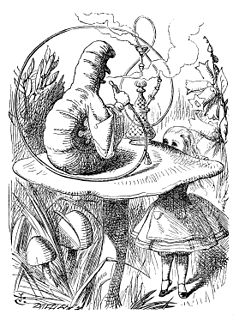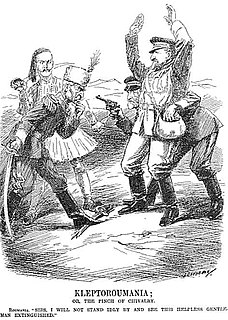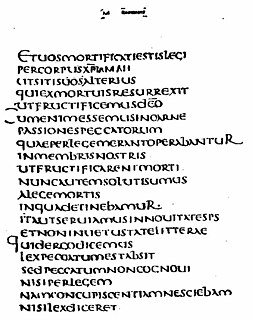
Ambiguity the type of meaning in which a phrase, statement or resolution is not explicitly defined, making several interpretations plausible. A common aspect of ambiguity is uncertainty. It is thus an attribute of any idea or statement whose intended meaning cannot be definitively resolved according to a rule or process with a finite number of steps.
The Berry paradox is a self-referential paradox arising from an expression like "The smallest positive integer not definable in under sixty letters".

A pun, also known as paronomasia, is a form of word play that exploits multiple meanings of a term, or of similar-sounding words, for an intended humorous or rhetorical effect. These ambiguities can arise from the intentional use of homophonic, homographic, metonymic, or figurative language. A pun differs from a malapropism in that a malapropism is an incorrect variation on a correct expression, while a pun involves expressions with multiple interpretations. Puns may be regarded as in-jokes or idiomatic constructions, especially as their usage and meaning are usually specific to a particular language or its culture.
In linguistics and related fields, pragmatics is the study of how context contributes to meaning. The field of study evaluates how human language is utilized in social interactions, as well as the relationship between the interpreter and the interpreted. Linguists who specialize in pragmatics are called pragmaticians.

A figure of speech or rhetorical figure is a word or phrase that intentionally deviates from ordinary language use in order to produce a rhetorical effect. Figures of speech are traditionally classified into schemes, which vary the ordinary sequence of words, and tropes, where words carry a meaning other than what they ordinarily signify.
In grammar, a conjunction is a part of speech that connects words, phrases, or clauses that are called the conjuncts of the conjunctions. That definition may overlap with that of other parts of speech and so what constitutes a "conjunction" must be defined for each language. In English, a given word may have several senses and be either a preposition or a conjunction, depending on the syntax of the sentence. For example, after is a preposition in "he left after the fight" but is a conjunction in "he left after they fought". In general, a conjunction is an invariable (non-inflected) grammatical particle that may or may not stand between the items conjoined.
Syntactic ambiguity, also called structural ambiguity, amphiboly or amphibology, is a situation where a sentence may be interpreted in more than one way due to ambiguous sentence structure.
The use–mention distinction is a foundational concept of analytic philosophy, according to which it is necessary to make a distinction between using a word and mentioning it. Many philosophical works have been "vitiated by a failure to distinguish use and mention". The distinction can sometimes be pedantic, especially in simple cases where it is obvious.
A dangling modifier is a type of ambiguous grammatical construct whereby a grammatical modifier could be misinterpreted as being associated with a word other than the one intended. A dangling modifier has no subject and is usually a participle. A writer may use a dangling modifier intending to modify a subject while word order may imply that the modifier describes an object, or vice versa.
Pleonasm is redundancy in linguistic expression, such as "black darkness" or "burning fire". It is a manifestation of tautology by traditional rhetorical criteria, and might be considered a fault of style. Pleonasm may also be used for emphasis, or because the phrase has become established in a certain form. Tautology and pleonasm are not consistently differentiated in literature.
Parsing, syntax analysis, or syntactic analysis is the process of analyzing a string of symbols, either in natural language, computer languages or data structures, conforming to the rules of a formal grammar. The term parsing comes from Latin pars (orationis), meaning part.
A garden-path sentence is a grammatically correct sentence that starts in such a way that a reader's most likely interpretation will be incorrect; the reader is lured into a parse that turns out to be a dead end or yields a clearly unintended meaning. "Garden path" refers to the saying "to be led down [or up] the garden path", meaning to be deceived, tricked, or seduced. In A Dictionary of Modern English Usage (1926), Fowler describes such sentences as unwittingly laying a "false scent".
A weasel word, or anonymous authority, is an informal term for words and phrases aimed at creating an impression that something specific and meaningful has been said, when in fact only a vague or ambiguous claim has been communicated. Examples include the phrases "some people say", "it is thought", and "researchers believe". Using weasel words may allow one to later deny any specific meaning if the statement is challenged, because the statement was never specific in the first place. Weasel words can be a form of tergiversation and may be used in advertising, (popular) science, opinion pieces and political statements to mislead or disguise a biased view or unsubstantiated claim.
Shall and will are two of the English modal verbs. They have various uses, including the expression of propositions about the future, in what is usually referred to as the future tense of English.
In linguistics, prosody is concerned with elements of speech that are not individual phonetic segments but are properties of syllables and larger units of speech, including linguistic functions such as intonation, stress, and rhythm. Such elements are known as suprasegmentals.

A word can be generally defined as a basic element of language that carries an objective or practical meaning, can be used on its own, and is uninterruptible. Despite the fact that language speakers often have an intuitive grasp of what a word is, there is no consensus among linguists on its definition and numerous attempts to find specific criteria of the concept remain controversial. Different standards have been proposed, depending on the theoretical background and descriptive context; these do not converge on a single definition. Some specific definitions of the term "word" are employed to convey its different meanings at different levels of description, for example based on phonological, grammatical or orthographic basis. Others suggest that the concept is simply a convention used in everyday situations.
In the linguistic sub-fields of applied linguistics and pragmatics, a hedge is a word or phrase used in a sentence to express ambiguity, probability, caution, or indecisiveness about the remainder of the sentence, rather than full accuracy, certainty, confidence, or decisiveness. Hedges can also allow speakers and writers to introduce ambiguity in meaning and typicality as a category member. Hedging in category membership is used in reference to the prototype theory, to signify the extent to which items are typical or atypical members of different categories. Hedges might be used in writing, to downplay a harsh critique or a generalization, or in speaking, to lessen the impact of an utterance due to politeness constraints between a speaker and addressee.

Short Message Service (SMS) language, textspeak, or texting language is the abbreviated language and slang commonly used in the late 1990s and early 2000s with mobile phone text messaging, and occasionally through Internet-based communication such as email and instant messaging.

Sarcasm is the caustic use of words, often in a humorous way, to mock someone or something. Sarcasm may employ ambivalence, although it is not necessarily ironic. Most noticeable in spoken word, sarcasm is mainly distinguished by the inflection with which it is spoken or, with an undercurrent of irony, by the extreme disproportion of the comment to the situation, and is largely context-dependent.
Sam Glucksberg was a Canadian professor in the Psychology Department at Princeton University in New Jersey, known for his works on figurative language: metaphors, irony, sarcasm, and idioms. He is particularly known for manipulating the Candle Problem experiment which had participants figure out the best way to erect a candle on a wall. Along with performing experiments, Glucksberg has also written Understanding Figurative Language: From Metaphors to Idioms, published by Oxford University Press in 2001.





